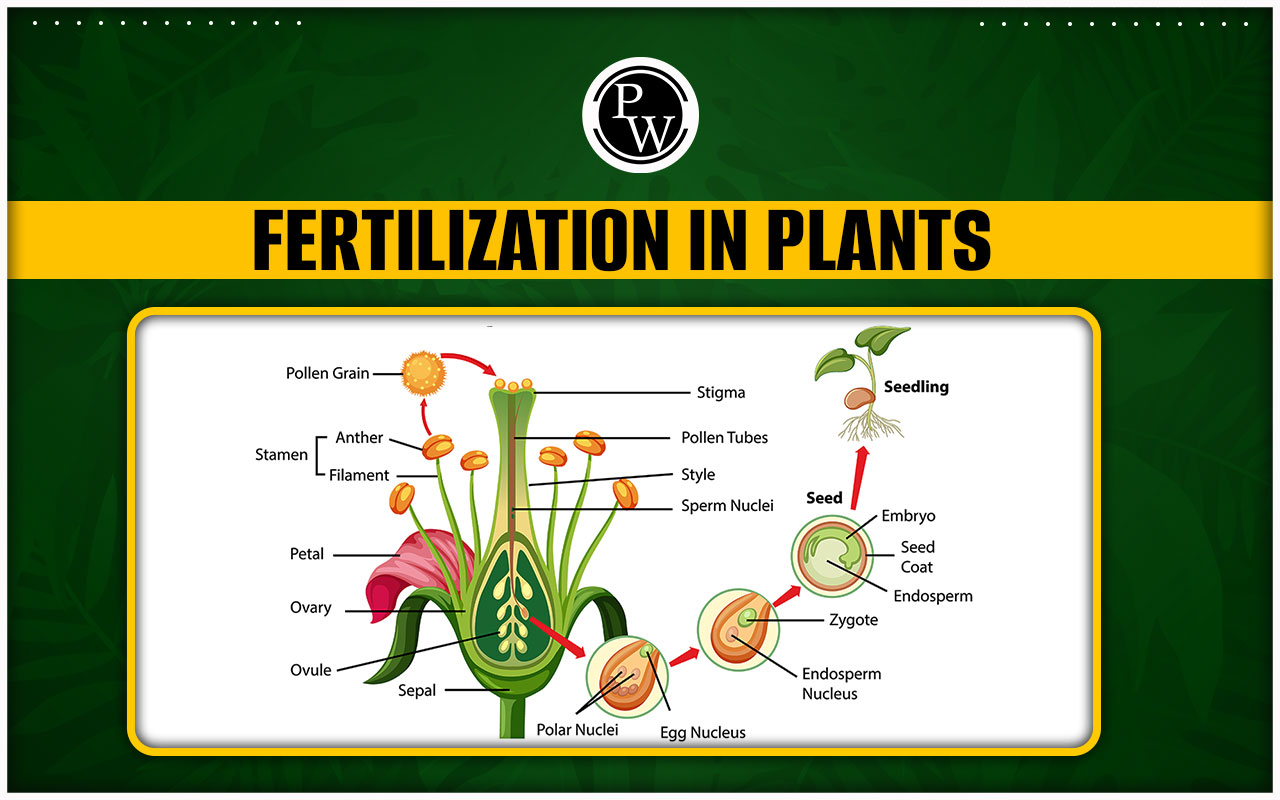

If you are excited to learn about fertilisation in plants, you have come to the right place!
In this article, we will discuss the major event of sexual reproduction i.e. fertilisation, specifically in plants. We will start with a brief intro to fertilisation, then the unique type of fertilisation that occurs in plants named double fertilisation, and at the end its significance. Every minute detail about this unique fertilisation will be explained one by one. The article aims to provide information about double fertilisation and its significance in plants.Introduction
Before learning about fertilisation one should know the term ‘Sexual reproduction’. Sexual reproduction is a type of reproduction in which a male and female gamete from the same or different parents is involved in producing new organisms. It comprises three major events- Pre-fertilization involves the formation of gametes and gamete transfer, then Fertilization, and the last event the post-fertilization event involves embryo development. Our main focus of study would be fertilisation. So, the fusion process of a male and female gamete to form the zygote is called fertilisation. In another term, it is also known as syngamy. This fusion process is normal in all organisms involving only one male and one female gamete. Here fusion takes place only once. But in plants, fertilisation is more complex. Because rather than one, it involves two different types of fusion, this gives uniqueness to plants, hence termed ‘double fertilisation’. Now, this unique type of fertilisation creates curiosity, and many questions pop up in our mind, such as where this double fertilisation takes place, and what these two types of fusion are. So, let’s start exploring more details about ‘Fertilisation in Plants’.Fertilisation in Plants
Pre-Fertilization Events
Pre-fertilization, or the process preceding the fusing of gametes, occurs before actual fertilisation. Two things occur before fertilisation: The development of male and female gametes. Gamete transfer occurs when the male and female gametes come close together.Gametogenesis
It is the process through which gametes are formed. Within the anther, male gametes are created. Microsporogenesis and micro gametogenesis are the stages. Megasporogenesis and Megagametogenesis are the processes the female gametes undergo to develop inside the ovules. This is an explanation of the structures and the procedure.Structures
Let's examine the specifics of the structures involved in the gametogenesis process.- Epidermis, endothecium, middle layers, and tapetum make up its four walls, forming the microsporangium (pollen sac) which creates the pollen grains. The pollen sacs are four in number. A collection of tightly packed homogeneous tissues called sporogenous tissues make up the centre of each sac.
- Ovules: The location where female gametes are formed. They are located at the base of a vase-like structure called a carpel, which also contains an aperture at the top called the stigma and a neck called the style.
- Pollen grains come in a range of sizes. They have two walls: an inner wall known as an endospore, made of cellulose, and an exterior wall made of sporopollenin.
- The structure of the anther has two lobes. The strip of the sterile section is joined to the two lobes.
- The filament is a stalk that makes up the stamen. The filament's proximal end is joined to the thalamus, a flower petal.
- creation of male gametes
Microsporogenesis
- In the pollen sac of an anther known as a microsporangium, microspores or pollen grains first develop through microsporogenesis.
- Using meiosis, the diploid pollen mother cell produces four haploid microspores.
- Each microspore matures into a pollen grain.
Microgametogensis
- Microgametogenesis is the process through which male gametophytes develop from pollen grains.
- A pollen grain goes through mitosis and divides into two types of cells: small generative cells and large vegetative cells. This is where pollination happens.
- While the vegetative cells give rise to the pollen tube, the generative cells produce two male gametes.
Megasporogenesis of Female Gametes:
- Within the megasporangium, the megaspore grows through megasporogenesis.
- The process happens inside the nucellus, a component in the ovule.
- The ovule's diploid megasporocyte goes through meiosis to split into four haploid megaspores.
- While the other three megaspores disintegrate, only one matures into a megagametophyte.
Megagametogenesis
- The functioning megaspore produces the female gamete through megagametogenesis.
- The megaspore goes through three rounds of mitosis and produces an embryo sac with eight nuclei.
- At first, there are 4 nuclei in each micropyle and chalaza end. One from each pole fuses at the centre during fertilisation to form a diploid nucleus.
- Later, the three cells at the chalaza end disintegrate.
Pollination
The pollen grains from the many blooms of the same species fall onto the stigma and join with the style length to form a pollen tube that joins the stigma and ovary, starting the pollination process. The male gametes are housed in the pollen tube, which will ultimately fuse with the egg cell to form the embryo. Fertilisation is when the male gamete and egg combine to create a zygote, which then develops into a seed. From seeds, new plants grow.Pollination Methods
There are essentially two forms of pollination:- Autogamy or self-pollination and
- Allogamy or cross-pollination.
- Pollination brings blooming plants' non-motile male and female gametes closer together so that syngamy or fertilisation can occur.
- Cross-pollination introduces novel gene combinations, which aid species development.
Pollen Germination
- Pollen starts germinating if the stigma is receptive and touches a compatible species.
- A brief cytoplasmic extension known as a germ tube, which developed during the degeneration of a pollen tube, emerges from the germ pore carrying the intine (the interior integument of a pollen grain) and its contents.
- Calcium-boron-inositol sugar complex molecules responsible for the pollen tube's direction towards the ovary cause it to be positively chemotropic and negatively aerotropic. (grows away from the air).
- The pollen tube's development is stimulated and nourished by the sucrose solution released by the stigma's epidermal cells.
- To pass through the stigma, style tissues, and reach the ovule, the pollen tube generates certain enzymes.
- The vegetative or tube nucleus and the generative nucleus are the two nuclei that make up the pollen tube.
- The pollen tube's tube nucleus, located at the tip, directs the pollen tube's development until it eventually disintegrates.
- Male gametes are two male nuclei created when the generative nucleus splits via mitosis.
- Through a tiny aperture known as the micropyle, the pollen tube develops and penetrates the ovule.
- The filiform mechanism, which directs the pollen tube's entrance, allows the pollen tube to enter one of the synergids.
Double Fertilisation
- One of the synergids breaks down after getting inside the embryo sac.
- The synergids' cytoplasm is where the two male gametes are released from the pollen tube.
- Primary fertilisation: The diploid zygote is created when the egg nucleus and one of the male gametes (n) fusion together (2n). It's also referred to as syngamy, and it's the first fertilisation process.
- Second fertilisation: In the centre cell, the other male gamete relocates and fuses with the secondary diploid nucleus or the two polar nuclei, (formed by the fusion of 2 polar nuclei). The primary endosperm nucleus, a triploid nucleus, is created by this fusion. The second fertilisation process or triple fusion is used to describe this procedure.
Post-Fertilization Events
- The seed embryo is created by mitotic division of the diploid zygote (2n).
- The primary endosperm nucleus (PEN), also known as the triploid nucleus (3n), develops into a mass of tissue that becomes the seed's endosperm. The developing embryo receives nutrition from the endosperm.
- The stigma, style, and petals wilt and typically fall off.
- If the calyx is intact, it will either fall off or take on the dry, shrivelled appearance of a tomato, guava, etc.
- The fruit wall is part of the ovary wall as it enlarges to become the fruit. A soft fruit wall or a dry, hard fruit wall can develop from the ovary wall.
- Ovules form seeds.
Fertilisation Significance
- Have you ever considered how a flower converts into a fruit? How are the seeds of a plant formed?
- The answer to the above questions is ‘Double Fertilization’ because seeds and fruit result from double fertilisation. Without this unique fertilisation, a plant can not have fruits and seeds.
- Once the double fertilisation is completed- the zygote and the PEN are formed. Further, during post-fertilization events, the zygote is developed into the embryo.
- The PEN is converted into the endosperm that will nourish the developing embryo; without an endosperm, the embryo cannot develop. Have you ever wondered why coconut water is considered among the healthiest drink?
- All credit goes to the endosperm because the water inside the green coconut is nothing but its endosperm which is highly rich in minerals, ions, and nutrients.
- During post-fertilization events, the flower's ovary converts into the fruit, the ovule converts into the seed, and this seed has its embryo inside it to help germinate it.
Related Links -
Fertilisation in Plants <span style=
1. What exactly are double and triple fertilisations?
The female gamete and the secondary nucleus are fused by one male gamete and the other by the other. Double fertilisation is the term used to describe the process in which two male gametes participate, and fertilisation occurs twice. It is known as triple fusion because three gametes are involved.
2. What distinguishes double fertilisation from normal fertilisation?
Syngamy is the process of fertilising two gametes. Triple fusion refers to the process of the sperm cell and central cell fertilisation. In angiosperms, the fertilisation of gametes is referred to as double fertilisation since the embryo sac is fertilised twice. The ovule transforms into the seed following fertilisation.
3. Who made the double fertilisation discovery?
Nawaschin observed "double fertilisation" in the liliaceous plants Lilium martagon and Fritillaria tenella in 1898. This process involves fusing one sperm with the egg cell to create the embryo and the second sperm with the polar fusion nucleus to produce the endosperm.
4. Does double fertilisation happen in humans?
No. An egg and a sperm are required for human fertilisation to result in the growth of a new human being. Two egg cells cannot be fertilised at this time. This is something reproductive medicine has been able to accomplish.
🔥 Trending Blogs
Talk to a counsellorHave doubts? Our support team will be happy to assist you!

Free Learning Resources
PW Books
Notes (Class 10-12)
PW Study Materials
Notes (Class 6-9)
Ncert Solutions
Govt Exams
Class 6th to 12th Online Courses
Govt Job Exams Courses
UPSC Coaching
Defence Exam Coaching
Gate Exam Coaching
Other Exams
Know about Physics Wallah
Physics Wallah is an Indian edtech platform that provides accessible & comprehensive learning experiences to students from Class 6th to postgraduate level. We also provide extensive NCERT solutions, sample paper, NEET, JEE Mains, BITSAT previous year papers & more such resources to students. Physics Wallah also caters to over 3.5 million registered students and over 78 lakh+ Youtube subscribers with 4.8 rating on its app.
We Stand Out because
We provide students with intensive courses with India’s qualified & experienced faculties & mentors. PW strives to make the learning experience comprehensive and accessible for students of all sections of society. We believe in empowering every single student who couldn't dream of a good career in engineering and medical field earlier.
Our Key Focus Areas
Physics Wallah's main focus is to make the learning experience as economical as possible for all students. With our affordable courses like Lakshya, Udaan and Arjuna and many others, we have been able to provide a platform for lakhs of aspirants. From providing Chemistry, Maths, Physics formula to giving e-books of eminent authors like RD Sharma, RS Aggarwal and Lakhmir Singh, PW focuses on every single student's need for preparation.
What Makes Us Different
Physics Wallah strives to develop a comprehensive pedagogical structure for students, where they get a state-of-the-art learning experience with study material and resources. Apart from catering students preparing for JEE Mains and NEET, PW also provides study material for each state board like Uttar Pradesh, Bihar, and others
Copyright © 2025 Physicswallah Limited All rights reserved.











